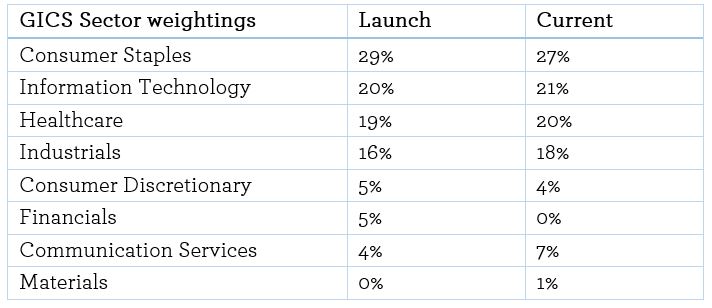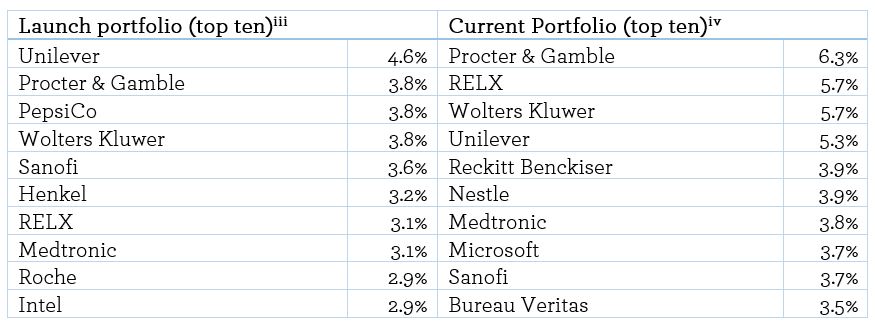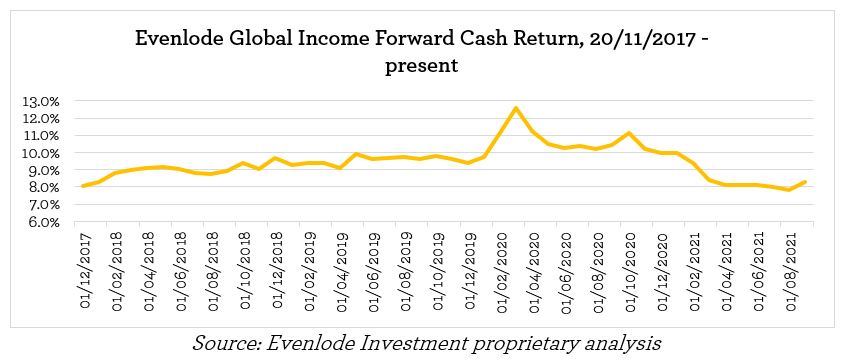The commentary below applies to both the Evenlode Global Dividend and Evenlode Global Income portfolios. Market data is from Factset and FE Analytics, corporate valuation analysis from ourselves at Evenlode.
Last month we found ourselves balancing short-term news-flow with long-term reflections. The third quarter reporting season has begun in earnest, giving investors a window into companies’ post-pandemic plans and ambitions. At the same time, we are rapidly approaching the fourth anniversary of Evenlode Global Income. When we launched the fund in late November 2017, we could not have imagined the macro events that were to follow. As the economic recovery from the pandemic continues, we would like to sincerely thank all those who have invested alongside us over a truly remarkable period and look forward to (hopefully) a smoother next four years!
Third quarter results
At the time of writing, over 55% of the portfolio has reported results since the start of October. The tone of management teams remains cautiously optimistic, whilst often lapping relatively easy comparative earnings from the prior year. We will give a broad update on results in our next investment view (after more companies have updated), but here we consider the short- and long-term dynamics on two companies, Unilever and CH Robinson, following their Q3 results.
Unilever, the consumer goods giant, reported 4.4% underlying sales growth for the year to date. More than 100% of revenue growth [i] in the third quarter was driven by price increases in response to rising input costs, demonstrating the company’s strong pricing power. Unilever generates 60% of sales in emerging markets that frequently feature (sometimes extreme) bouts of inflation. This has required the company to develop an understanding of when and how far to raise prices, and the likely knock-on effect on volumes. With management expecting input cost inflation to peak mid-2022, this experience will prove invaluable over the coming year. Having comfort that the company can withstand these short-term cyclical inflation pressures allows us to concentrate on the long-term investment case.
The global pandemic has accelerated the transition to online retail with many consumers replacing the weekly trip to the shop with supermarket deliveries. In 2017, Unilever generated only 4% of sales via ecommerce. This year, online shopping accounts for 12% of sales and continues to grow rapidly (+38% in the last quarter). Assuming continued growth in future sales through digital channels, how will this affect Unilever? When purchasing online, the consumer has fewer physical quality indications (such as packaging, weight, or promotional position) and is left more dependent on the brand to convey quality. Unilever generates 80% of sales from brands that are number one or two in their respective markets and is focusing marketing investment behind these. This transition has a positive potential tailwind for brand owners.
CH Robinson provides third party logistics software and services, linking thousands of suppliers with a network of road, sea and air delivery companies. CH Robinson has increased revenue by 42% [ii] year to date, as a tight labour market in transportation has led shipping costs to increase and this has a proportional increase in the fees that brokers, such as CH Robinson, can charge its customers. This effect has been most acute in sea shipping, where prices per load have doubled year-on-year. However, the higher price also increases the suppliers’ need to utilise specialist brokers, to both ensure delivery capacity and to seek cost efficiencies. While we expect some reversion as the market loosens in 2022, our expectation is that CH Robinson will retain most of the new client relationships.
With the increased costs and complexity of logistics, the brokerage process is increasingly requiring automation. CH Robinson has led technology investment with its Navisphere platform, which allows customers to rapidly compare shippers and automatically place and agree the price of deliveries. As a result, CH Robinson has increased shipments placed per broker by 30% since late 2017. Over the cycle, this will reduce costs and increase the integration of CH Robinson’s services into customer operations. With the automated share of US surface shipping volumes expected to increase from 50% of spot orders to 90%, there is a long runway for margin growth and industry consolidation around the best platforms.
Four-year anniversary
As we near the fourth anniversary of Evenlode Global Income, it is interesting to compare the current portfolio with the one we had on launch in 2017.
From launch, we have deliberately adopted a low turnover approach, only trading when the market offers us a material upgrade to the risk-reward balance of the portfolio. Even so, the similarities between the current and launch portfolios are striking. Of the 37 companies held on launch; we still retain 19 in the current portfolio. Both then and now, these names make up almost 60% of the total portfolio by weight. Given our strategy to pick companies that can retain high returns for an extended period, this is very reassuring! However, individual position sizes have meaningfully changed in response to valuations. Our PepsiCo position peaked at almost 7% but is now less than 2%. RELX declined to only a toehold position of 1% but is now just over 5.5%.

Every company in our investable universe is valued using our proprietary valuation model. This provides us with a measure, the Forward Cash Return (FCR), that estimates the long-term return to the equity holder. This is plotted in the chart below:
When we launched the fund, we expected the companies in the portfolio to generate an average return of approximately 8% per year. Despite the unpredictability and volatility over the past few years, the portfolio has returned 51% (after costs) since launch [vi]. This is equivalent to an annualised return of just over 11% (again, after costs), well exceeding our initial prediction. Currently, our FCR stands once more at 8% (another similarity!). Recent market volatility has demonstrated that such returns will not be earned on a year-by-year basis (calendar year returns since launch after costs have been 1.83% in 2018, 24.33% in 2019 and 3.51% in 2020, with year to date returns for 2021 running at 14.13% [vii]). However, we do believe that the best chance of achieving good long-term returns lies in the careful company analysis that we undertake and the ongoing hard work of our entire investment team. We very much hope that we will be able to look back on similar cheerful results for our investors when the fund celebrates its eighth anniversary in 2025!
Ben, Chris, Bethan, and the Evenlode Team
25th October 2021





